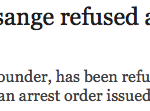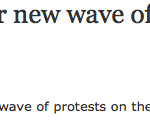Get skim-readers to pay attention to your blog posts. How? Start using a ‘lead’, like newspapers do. This post will tell you why & show you how.
What is a ‘lead’?
A lead is the one-paragraph explanation at the top of an article. I’ve crafted one at the top of this blog post, in italics, as an example. (Though it’s not perfect – I’m still learning too!)
The term ‘lead’ comes from the newspaper industry, where a lead is used as a micro-story under the headline to emphasise what made the story ‘newsworthy’ in the first place. In your blog post, you should use a lead to emphasise what made your story bloggable. Aim to write a short, focused summary that highlights the point of your blog post AND encourages people to read on.
Why you should use a lead:
 You’ve probably heard time and time again that Internet users have a short attention span, right? Oh, and don’t forget nobody reads anything anymore – it’s all about skim reading.
You’ve probably heard time and time again that Internet users have a short attention span, right? Oh, and don’t forget nobody reads anything anymore – it’s all about skim reading.
So, use a lead to capture attention, to hook users in.
Using a lead will draw in passive skim-readers. It will encourage people to give your article their full attention. It will tell people WHY it’s worth reading (i.e. why it was bloggable, or newsworthy in the first place) and why it’s worth their time and effort.
Examples of leads:
Here are some examples of leads from today’s news:
As you’ll notice, under each headline is a small summary of the story. The Guardian uses bullet points on its website, which I think is a fantastic idea!
What to put in your lead:
Here are a few basic tips to get you started:
- Talk about the actor and the action:
- Who did what?
- Make sure you include the main event:
- Hook people in by explaining specifically what is going on where…
- Tell people what made this worth blogging:
- Was there unexpected conflict?
- Were the ‘elite’ involved? (For example, Google, a footballer or just somebody well known in your niche).
- What’s the value, is there something in it for people? (E.g. a freebie or a new tip to help make people more money)
EXAMPLE: Joe Bloggs explains his suprising reasons for cancelling 2011 SEO conference talk in London, just hours before taking to the stage.
We can pretend that, in this example, Joe Bloggs is an elite character in the industry. The fact that his reasons are ‘suprising’ and he let people down just ‘hours before taking to the stage’ makes this story newsworthy. We’re setting the context by including “who, what, where”.
TIP: Pay attention to the leads used in newspapers (or on news websites) to get a sense for what draws you in. Try and replicate these in your own blog post leads.
TIP: Writing a really lead will come with experience and tweaking. If you have the time and resources, try running an A/B split test to see if particular leads result in a lower bounce/exit rate and a higher average time on page value. Then, note which are more successful and work out why.
How to write a good lead for your blog:
- Make sure it’s packed with information
- But keep it short – aim for one short paragraph
- Ensure it’s clear, concise, focused and to the point
- Emphasise what made the story worth blogging in the first place
QUESTION: How long should my lead be?
Try and stick to about 30 words. You have very limited time to capture potential readers’ attention, so help them grasp the meaning very quickly, pulling them in to read the rest of your blog post.
A few weeks ago I was in my news-making class learning about newspaper leads and why they’re important . I thought “we should really apply this to blogging too” so I wrote this post to share with you all. The ideas come from a chapter in this book: “The Language of News Media (Language in Society)” by Allan Bell, which we read in preparation for the class.



Superb post. Short copy skills are indispensable for this though, as it’s going to be hard to condense difficult or challenging posts into 30 words or less.
Really great post! I never thought about a lead to capture the audience. You have definitely given me something to work on.
This is really awesome, I just knew it! I’ll learn more about this. Thanks Sister 🙂
Haven’t thought about this bout sounds like a great idea. I will have to give it a try.
Haven’t thought about this bout sounds like a great idea. I will have to give it a try.
Hey Carly, what a great tip! I will definitely start implementing this strategy in my blog post. Thanks for sharing!Take Care!Sherman
Carly, this is some great information. I do agree that we only a very limited time to capture our readers attention, so the lead must be clear and to the point. Thanks for the share!
I am a newbie in blogging but I find this tip as very helpful to my blogs 🙂